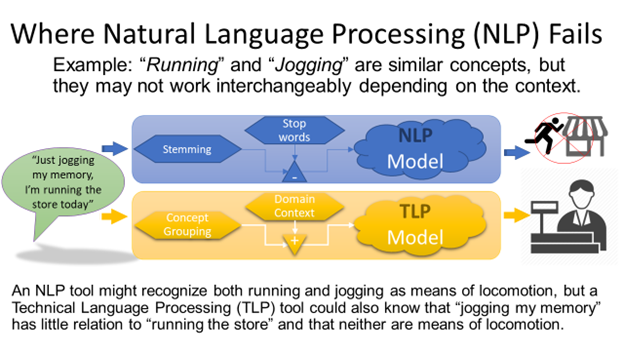Working With Workspace Words: NIST Helps Compose Technical Language Processing Tutorial at PHM 23

NIST helped to foster awareness, debate, and education at the Technical Language Processing (TLP) Tutorial of the 15th Annual Conference of the Prognostics and Health Management (PHM) Society in Utah. This event resulted from the collaborative effort of the NIST TLP Community of Interest (COI) (including TCP COI leadership Rachael Sexton, Engineering Laboratory, and Michael Sharp, Communications Technology Laboratory) and our external partner, the Logistics Management Institute (Sarah Lukens). The tutorial attracted 200 attendees, with a goal to increase awareness of TLP industrial applications to reliability and maintenance. The tutorial provided an overview of what differentiates technical language from natural language, provided an overview of some basic processes and algorithms, and highlighted the NIST-led resources within the TLP COI.
The tutorial was very well received, with significant attendee interest in language processing tools used in industry. This interest was echoed throughout the conference, with a panel that discussed the use of Large Language Models (LLMs) in PHM, and several papers that were presented on related topics:
- Performance of ChatGPT
- TLP-based Data Labeling
- TLP Application to Aircraft System Troubleshooting
- Natural Language Processing-based Fault Diagnosis of Plastic Bearings
Additionally, during the tutorial, attendees discussed both the growing role of generative artificial intelligence (AI) in industry and the new U.S. Executive Order on AI. Although many individuals and some companies expressed their excitement to be early adopters of LLMs and support the U.S. AI initiative, the broader PHM community has yet to provide a unified stance on the subjects amid uncertainty of how best to move forward. Some suggested that prioritization and implementation of use cases from stakeholders and leading organizations could jumpstart the uptake initiatives. Towards this end, attendees expressed interest in obtaining guidance and reasonable assurance of quality, reliability, and availability in tools, noting that while tools like LLMs are currently free and easy to access, that may change in the future. One attendee concluded in anticipation of a presumed suite of new LLM-based tools “Let’s not throw out our best practices in engineering just because we have a shiny new toy.”
The LLMs discussions included input on developments in the software solution space, in which many companies are looking at ways to monetize LLMs as potential tools to solve varying stakeholder needs. Attendees identified end-to-end solutions to connect spoken/written word and a physical part as a high value target for the manufacturing and design communities: e.g., asking LLMs to design a part, linking it to software and a 3D printer, and having a prototype part produced locally. Another high value target that sparked significant interest aimed at extracting and processing text from images of technical documents such as piping and instrumentation diagrams (P&IDs) and failure mode and effect analyses (FMEAs). Capturing both text and pictographic relations in a technical specification document could accelerate digital twin model development and make processing incoming logs or requests much more efficient.
The slide deck for this event is available upon request (email: michael.sharp [at] nist.gov (michael[dot]sharp[at]nist[dot]gov)) and a recorded version is available on the PHM website.

